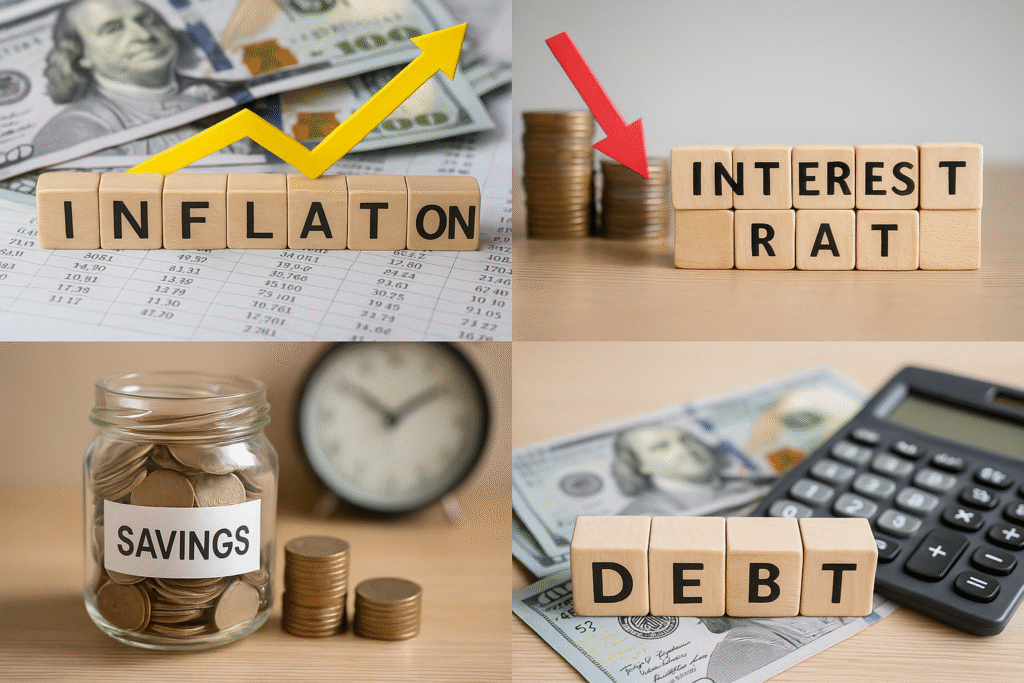Inflation and Interest Rates Affect You: Inflation and interest-rate moves sound like central-bank jargon — until they change your grocery bill, mortgage payment, or the interest you earn on savings. This guide explains, step-by-step and plain-English, what inflation is, how the Federal Reserve uses interest rates to fight or accommodate it, and exactly what you can do with your savings, debt, and financial plan right now. All numeric and policy references are based on official U.S. government sources .
1. Quick primer: what inflation is and how it’s measured
Inflation is the general rise in prices for goods and services over time — not the price of one item, but an economy-wide trend. The U.S. government’s primary measure of consumer inflation is the Consumer Price Index (CPI), which tracks a representative “basket” of items (food, housing, transport, medical care, etc.). CPI changes tell us whether the things you buy are, on average, getting more expensive or cheaper. (Federal Reserve, Bureau of Labor Statistics)
Why CPI matters to you: CPI (and related measures like the Personal Consumption Expenditures price index used by the Fed) is what policymakers watch to decide whether to raise, hold, or cut short-term interest rates. Those rate decisions filter down to the interest you pay and earn. (Federal Reserve)
2. How the Fed uses interest rates to fight inflation — the basic mechanics
The Federal Reserve (the Fed) influences the economy primarily by changing its policy rate (the federal funds rate) and by managing broader financial conditions. When inflation is running above the Fed’s goal (the Fed targets ~2% inflation over time), the Fed can raise short-term rates to cool demand — that tends to slow hiring and spending and can lower inflation over time. Lowering rates tends to stimulate activity when inflation is too low. These changes don’t affect every market immediately, but they are the central tool. (Federal Reserve)
Transmission to households: higher policy rates generally lead to higher borrowing costs (mortgages, credit cards over time) and — eventually — higher deposit rates on savings accounts and CDs. The timing and size of these pass-through effects vary by product and bank. (FDIC)
3. The headline you read — “mortgage rates today” — and what it actually means for you
When news sites report “mortgage rates today,” they usually mean the average market rate for 30-year fixed mortgages (surveyed weekly by Freddie Mac and others). Your personal rate depends on your credit score, down payment, loan type, loan-to-value (LTV), and points you pay. Even when the Fed raises or lowers rates, your mortgage rate moves only as market expectations and bond yields change. Use market averages for context — not a guarantee of your individual quote. (Federal Reserve)
Actionable tip: when mortgage rates move, get multiple written Loan Estimates from lenders (same loan scenario) and compare APR, fees, and points — not just the headline rate.
4. For savers: inflation erodes purchasing power — here’s how to fight back
If inflation runs at 4% and your savings account pays 0.5% APY, your real return is about −3.5% (you lose purchasing power). To protect savings:
- Shop for better yield: look at FDIC-insured high-yield savings accounts, short-term certificates of deposit (CDs), or money-market accounts. Banks’ deposit rates often lag or lead Fed moves differently — compare APYs and fees. The FDIC provides guidance on deposit products and disclosure rules. (FDIC)
- Consider inflation-protected Treasuries (TIPS) or Series I Savings Bonds for part of your emergency funds or longer-term savings — these are government instruments that adjust with inflation. I-Bonds reset their inflation component every six months; TIPS adjust principal with CPI changes. Both are low-risk ways to preserve purchasing power. (I-Bond and TIPS details are on TreasuryDirect.) (TreasuryDirect)
- Ladder short-term CDs to capture rising rates while keeping liquidity (e.g., 3-, 6-, 12-month CDs). If rates rise, you reinvest at higher yields when each rung matures.
Practical balance: keep 3–6 months of living expenses in liquid accounts for emergencies (so you don’t cash investments during market dips), and allocate longer-term money to inflation-resistant options.

5. For borrowers: what higher rates mean and what to do
Higher policy rates usually push consumer borrowing rates up — especially variable-rate loans and new fixed mortgages. That means:
- Adjustable-rate loans can get more expensive when the index they use moves up after the fixed introductory period. Review the ARM caps and your exit plan. (Consumer Finance.gov)
- Refinancing to a lower fixed rate can save money when market rates fall; conversely, refinancing away from a fixed low rate during a rising-rate period may be costly. Calculate the break-even point: (closing costs ÷ monthly savings). If you expect to stay longer than the break-even, refinancing could make sense. (Consumer Finance.gov)
- Credit card and auto loan rates often follow market trends — prioritize paying down high-interest revolving debt first, because interest on those balances compounds quickly.
Practical steps:
- If you have variable-rate debt, consider moving to fixed-rate products when possible and affordable.
- Re-run refinance math whenever rates move significantly; use conservative estimates for future rate moves.
- If you expect higher rates for several years and plan to buy, price in the higher payment when budgeting for affordability.
6. How inflation changes the “real” value of wages and benefits
If your wages don’t rise as fast as inflation, your purchasing power falls. Some wages, pensions, and benefits are indexed to inflation (COLAs) — for example, certain federal benefits and tax brackets are adjusted periodically using CPI or other measures. Check official IRS and Social Security pages for how cost-of-living adjustments may affect your taxes and benefits. (IRS, Bureau of Labor Statistics)
What you can do: negotiate for COLA-linked raises where possible, prioritize paying down debts that are immune to inflation (fixed-rate mortgages become relatively cheaper over time if wages keep up), and maintain a diversified mix of assets that can protect purchasing power.
7. Investing: inflation and your portfolio
- Stocks can offer some inflation protection over the long term because companies can raise prices — but not every sector benefits equally (energy and commodities often do well; fixed-income suffers).
- Bonds lose value when yields rise (prices fall), but short-duration bonds and TIPS are less sensitive to rate moves.
- Real assets (real estate, commodities) often provide a hedge, but liquidity, fees, and local conditions matter.
Important: don’t make drastic portfolio changes based on a single inflation report. Rebalance to target allocation and consider increasing exposure to inflation-resistant instruments gradually if your long-term outlook changes.
8. Smart, practical moves you can do this month (action checklist)
- Check your emergency fund — keep 3 months (or more) liquid in a high-yield savings or a laddered set of short CDs.
- Shop bank rates — compare APYs on savings and short-term CDs; move a portion of idle cash to higher-yield FDIC-insured accounts. (Confirm FDIC insurance on any bank you use.) (FDIC)
- If you have high-interest credit card debt, prioritize paying that down — it’s typically more damaging than inflation’s erosion of cash.
- Consider small TIPS or I-Bond allocations for money you won’t need for 1–5 years (I-Bonds have holding/pricing rules). (TreasuryDirect)
- If you’re rate shopping for a mortgage or refinance, get Loan Estimates from multiple lenders and compute the refinance break-even. (Consumer Finance.gov)
- Review budgets for inflation creep (food, energy, housing) and cut low-value recurring expenses first.

9. Special consumer protections & official resources to use
- FDIC: check deposit insurance limits and disclosures before moving money to a new bank — especially if you’re splitting funds across accounts to get higher yields. (FDIC)
- Consumer Financial Protection Bureau (CFPB): has resources for comparing mortgages, understanding adjustable-rate mortgages, and consumer protections when rates move. (Consumer Financial Protection Bureau)
- TreasuryDirect: the official site for Series I Savings Bonds and TIPS information (both adjust with inflation). These are low-risk, government-backed tools to preserve purchasing power. (TreasuryDirect)
10. FAQ — short answers to common questions
Q: Does the Fed directly set mortgage and savings rates?
A: No. The Fed sets policy rates that influence market rates; banks and lenders set their own consumer rates based on market yields, costs, and competition. Expect lag and imperfect pass-through. (Federal Reserve, FDIC)
Q: Should I cash out investments when inflation rises?
A: Rarely a good idea. Selling on emotion can lock in losses. Revisit your time horizon, diversify, and consider adding inflation-protected assets rather than liquidating core long-term holdings.
Q: Are I-Bonds better than high-yield savings?
A: I-Bonds are inflation-linked and safe, but have purchase and redemption rules (e.g., 1 year minimum holding). High-yield savings offer immediate liquidity. Many savers use both for different parts of an emergency/liquidity ladder. (TreasuryDirect)
11. Final thought — focus on real returns and practical flexibility
Inflation and interest-rate cycles are normal parts of the economy. Your best defense is a combination of liquidity (emergency cash), protection (inflation-linked instruments), and flexibility (reduce high-cost debt). Monitor official measures (CPI, Fed statements), but translate them into a plan: what to keep liquid, what to lock in, and what debt to attack first.
Official government & authoritative resources (verified live Aug 2025)
(Use these pages to cross-check definitions, rates, and product rules. Each link was active when checked.)
- Federal Reserve — What is inflation? / How the Fed affects inflation & employment. (Federal Reserve)
https://www.federalreserve.gov/faqs/economy_14419.htm
https://www.federalreserve.gov/faqs/money_12856.htm - Bureau of Labor Statistics (BLS) — Consumer Price Index (CPI): overview and methodology. (Bureau of Labor Statistics)
https://www.bls.gov/cpi/home.htm - Freddie Mac — Primary Mortgage Market Survey (mortgage rates context & averages). (Federal Reserve)
https://www.freddiemac.com/pmms - U.S. Department of the Treasury — Series I Savings Bonds and I-Bond interest; TIPS and inflation-protected securities. (TreasuryDirect)
https://www.treasurydirect.gov/savings-bonds/i-bonds/i-bonds-interest-rates/
https://www.treasurydirect.gov/research-center/history-of-savings-bond/comparing-tips-to-i/ - FDIC — Deposit account disclosures and guidance for high-yield accounts; check FDIC insurance limits before moving deposits. (FDIC)
https://www.fdic.gov - Consumer Financial Protection Bureau (CFPB) — Tools and consumer guidance (mortgages, adjustable-rate loans, consumer protections). (Consumer Financial Protection Bureau)
https://www.consumerfinance.gov - IRS — COLA and retirement/benefit adjustments (cost-of-living adjustments that may affect you in inflationary periods). (IRS)
https://www.irs.gov/retirement-plans/cola-increases-for-dollar-limitations-on-benefits-and-contributions
Disclaimer
This article is for informational purposes only and is not financial, tax, or investment advice. Rates and policy can change; always confirm product details (APY, terms, FDIC coverage) with the official institutions listed above and consult a qualified financial professional before making major decisions. All images used in this article are royalty‑free or licensed for commercial use and are provided here for illustrative purposes.
